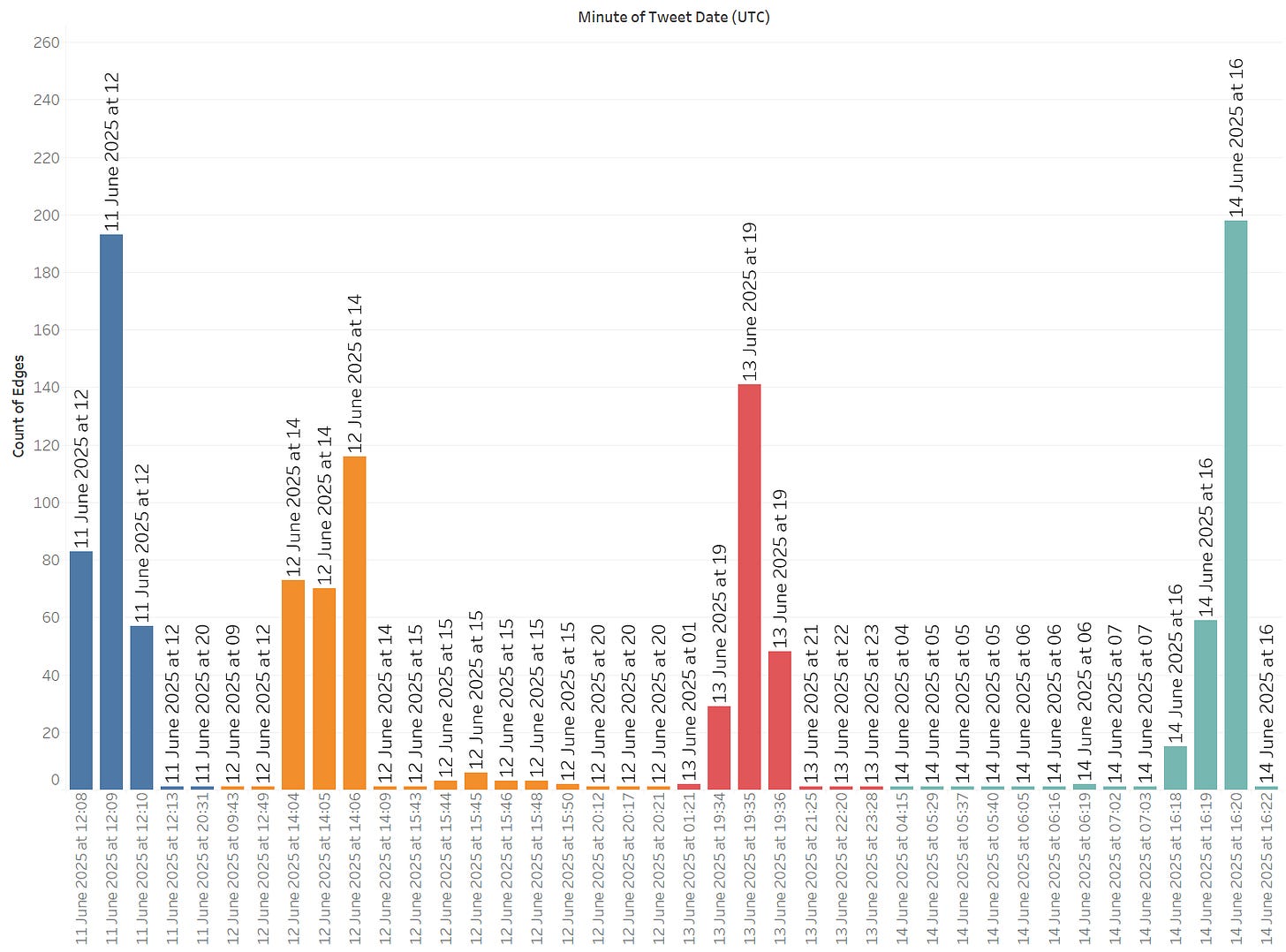Anti-Qatar Propaganda Botnet Trends on X
Over 560 fake accounts manipulate hashtags targeting Al Jazeera, Qatar, and Qatari political figures.
Key Findings
>560 bot accounts identified operating since March 16, 2025
Bots successfully game X’s regional trending algorithm
Accounts used identical technical signatures: Twitter Web App, 5 hashtags per tweet, random alphanumeric characters
Distinctive temporal pattern: Mass posting in 5-minute windows with 24-hour gaps between activities
Campaign themes reveal strategic incoherence: Simultaneously labeled Emir Tamim as "Zionist agent" and Iranian proxy, attacked Qatar for being both too close to Iran and supporting Sunni groups, criticized the country as both too religious and not religious enough - targeting sectarian tensions, economic grievances, media control, and geopolitical contradictions
AI-generated content including images created with Grok
Evasion tactics: Random characters to avoid detection algorithms
For-hire network characteristics suggesting commercial operation
Reduced content moderation on X/Twitter created fertile ground for coordinated inauthentic behavior
Introduction
The bots are back. Anti-Qatar bots were endemic during the blockade of Qatar by the UAE, Saudi Arabia, Egypt and Bahrain in 2017. The end of the blockade changed the online dynamic, but since October 7th, and Qatar’s mediation role in the Gaza genocide, online propaganda against Qatar has resurfaced. Now, Israeli attacks on Iran seem to have prompted renewed propaganda. Similarly, Elon Musk’s purchase of Twitter (now X) have rolled back safeguards against bot accounts and co-ordinated inauthentic behaviour.
In this post I classify, analyse and discuss that bots’ content, behaviour and activity.
Today, 14/06/2025, trending in Qatar are the following Arabic language hashtags:
العميل_الصهيوني_تميم = "The_Zionist_agent_Tamim"
الجزيرة_قناة_صفوية = "Al_Jazeera_Safavid_channel"
تميم_في_خدمة_الملالي = "Tamim_in_service_of_the_mullahs"
قطر_شريكة_طهران = "Qatar_partner_of_Tehran"
ايران_تخطط_قطر_تمول = "Iran_plans_Qatar_funds"
As you can see from the trending screenshot below, the suspicious hashtags all had identical number of posts (1269). If these were organic trends, it would be very unlikely that they would all have the same number of posts.
Analysis
I downloaded all accounts using NodeXL. Judging from a look at a sample of the accounts, they have tweeted once per day, and each day using a different batch of hashtags. I selected the hashtags based on sampling one unique tweet per day.
Suspicious accounts were characterised by a number of things: including using multiple hashtags per tweet. Almost all posted five hashtags per tweet.
A look back at the timeline also revealed that these accounts were also using random alphanumeric characters at the end of tweets - a tactic used to avoid bot detection.
After downloading a few of the suspect hashtags other patterns were clear. All accounts used ‘Twitter Web App’ to send the tweets. Again, the fact they all used the same platform is highly suspect and indicates coordination.
The temporal tweeting pattern was particular distinctive. In order to create trends, the network aims for high velocity, launching several hundred tweets in a small window. As the below graph shows, the network sends most of its tweets in a small 5 minute window, often with 24 hours passing between tweets. This is designed to maximise velocity. Each colour represents a different day, the height of the bar represents number of tweets sent
Overall I found at least 560 bot accounts. The anti Qatar operation appeared to go back to approximately 16th March 2025. Based on previous tweeting patterns, it looked like it may have been a for hire bot network contracted by a political entity.
Themes
Anti-Qatar Propaganda Campaign: Core Themes and Narratives
The content shared by the network is, broadly speaking, aimed at discrediting and smearing Qatar. Below are some of the hashtags trended by the network
#تميم_ربيب_الخوميني - #Tamim_Protégé_of_Khomeini
#قطر_تساعد_طهران - #Qatar_Helps_Tehran
#قناة_الجزيرة_عميلة - #Al_Jazeera_Channel_Agent
#قطر_عميلة_ايران - #Qatar_Agent_of_Iran
#الاخوان_خونة_الاوطان - #Muslim_Brotherhood_Traitors_to_Homelands
#تيوس_موزة - #Moza's_Goats
#حقوق_الانسان_قطر - #Human_Rights_Qatar
#خرفان_تميم - #Tamim's_Sheep
#المعارضة_القطرية - #Qatari_Opposition
#تميم_يتاجر_بغزة - #Tamim_Trades_in_Gaza
#القاضي_عبدالله_المهندي - #Judge_Abdullah_Al_Muhandi
#القاضي_علي_السليطي - #Judge_Ali_Al_Sulaiti
#موزة_تنقلب_على_تميم - #Moza_Turns_Against_Tamim
#قطر_عميلة_ايران_واسرائيل - #Qatar_Agent_of_Iran_and_Israel
#QatarGate
Discussion of themes
Betrayal of Arab Identity
The central narrative frames Qatar as fundamentally betraying its Arab heritage by serving Iranian interests. Emir Tamim is repeatedly labeled a "Zionist agent" serving Iran’s "mullahs," while Al Jazeera is characterized as a "Safavid channel." This sectarian framing exploits historical Persian-Arab tensions, with posts claiming that "Iran plans, Qatar funds" and positioning the country's relationship with Tehran as treasonous rather than pragmatic regional balancing.
Systematic Hypocrisy
The campaign highlights contradictions across Qatar's domestic and foreign policies. Posts emphasize how "Qatar supported the Arab Spring both in the media and politically, but it did not allow a spring within its own borders" and how the country "adopts a liberal discourse in Western media, a conservative one in Arab media, and an authoritarian one domestically." Military arrangements receive particular scrutiny: "Qatar hosts the Al Udeid American base while funding media that incites against American intervention in the region."
Economic Exploitation, Cronyism, and Authoritarian Control Through Fear
Economic grievances center on accusations that national wealth serves elite interests rather than citizen welfare. Posts claim that "positions in the state are not granted to the competent, but are distributed as spoils among relatives and close associates" and that "in Qatar, a job doesn't require a certificate... it requires connections." The campaign contrasts international investments with domestic neglect: "Qatar invests in European clubs while restricting sports and media freedom domestically" and "billions are wasted on showy projects, while the citizen sees no impact on education or health."
The repression theme emphasizes systematic suppression of dissent, with posts stating that "anyone who expresses their opinion is arrested, anyone who demands reform is accused of treason, and those who oppose face exile or imprisonment." The campaign portrays pervasive fear: "it is not possible to talk about human rights in a country where a citizen fears expressing their opinion even in their own home." Financial transparency becomes a forbidden topic: "in Qatar, you are not allowed to ask: 'Where is our money going?' because the question is considered a crime."
Al Jazeera
Al Jazeera receives sustained attack as a propaganda instrument rather than legitimate journalism. Posts argue that the channel "employs the rhetoric of opposition and freedom, but it does not present any opposition to the Qatari regime itself" and "highlights poverty and injustice in the world, but it does not address the problems of Qatari society." The broader media landscape is characterized as completely controlled: "in Qatar, the media is not the voice of the people, but the tongue of the ruler."
Religious Instrumentalization
The campaign targets Qatar's Islamic legitimacy, claiming the government "uses religious institutions to justify its foreign policies and polish its actions domestically" while "treating Islam as a political identity that can be utilized according to interest." Posts highlight contradictions: "Qatari political Islam calls for revolutions in other countries, but calls for loyalty and obedience within Qatar" and accuse Qatar of funding "religious associations in the West that adopt a political ideology more than a religious one."
Geopolitical Contradictions
Foreign policy receives extensive criticism for alleged inconsistency and opportunism. The campaign emphasizes how "Qatar claims diplomatic neutrality, but it clearly chooses sides in conflicts and supports them" and questions why the country "opens its doors to large American bases, while at the same time funding Islamic groups that are hostile to the West." Posts argue that "Qatar's support for the Muslim Brotherhood was not merely solidarity, but a comprehensive political project."
Inevitable Regime Change
The campaign employs historical determinism to suggest current arrangements are unsustainable. Posts reference how "all oppressive regimes have fallen over time" and assert that "change cannot be prevented forever, as the people do not forget those who oppressed them and stole their voice." This framing normalizes the expectation of political transformation while providing justification for opposition activities.
A recurring theme emphasizes how Qataris themselves are marginalized in their own country. Posts claim that "as foreign consultancy offices increase, Qatari youth are neglected and doors are closed to them" and ask "why does Qatar insist on supporting extremist organizations instead of supporting its own people?" This narrative positions the government as serving everyone except its own citizens.
Core Contradictions and Strategic Incoherence
The campaign seems to throw every possible criticism at Qatar regardless of logical consistency. This "kitchen sink" approach seems to reflect a desire to just criticise as much as possible about Qatar. Real political opposition typically has coherent alternative visions, while this material reads like a checklist of grievances designed to appeal to different audiences without regard for overall coherence. The most glaring inconsistency lies in simultaneously labeling Emir Tamim as both a "Zionist agent" and someone who serves Iranian "mullahs." This makes no geopolitical sense, as Israel and Iran are adversaries. Qatar's actual foreign policy involves maintaining relations with both the US (hosting a major military base) and Iran (sharing a gas field), which represents pragmatic balancing rather than serving either exclusively.
The campaign attacks Qatar for being too close to Iran (Shia-majority) while also criticizing it for supporting Sunni Islamist groups like the Muslim Brotherhood. It simultaneously condemns Qatar for being too religious (supporting Islamic movements) and not religious enough (instrumentalizing faith for politics). The "Safavid" references attempt to invoke anti-Persian sentiment, but Qatar is overwhelmingly Sunni Arab. Another element is the contradictory claim that Shaikha Moza (the mother of Tamin bin Hamad) is turning against Tamim, but the network also shares AI-generated images of Tamim and Moza in cahoots.
The network’s discussion of Shaikha Moza also reflects a theme common in the 2017 blockade, positioning her as a sort of eminence grise behind Doha’s politics.
The contradictory messages suggest the campaign is trying to appeal to multiple, incompatible constituencies simultaneously—Arab nationalists, Iranian hawks, democracy activists, religious conservatives, and economic populists—without recognizing that these groups have fundamentally different priorities and worldviews.
Content, including AI
The network also included AI-generated images, largely depicting scenes in line with the themes of the textual content. Some of the images were generated with Grok, based on the watermark. Below are a sample.
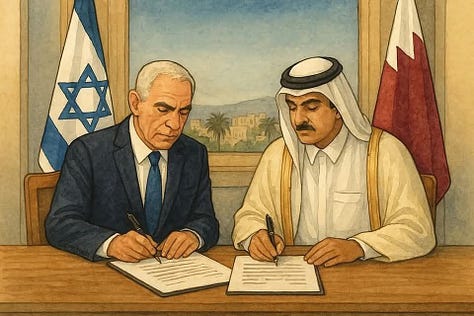

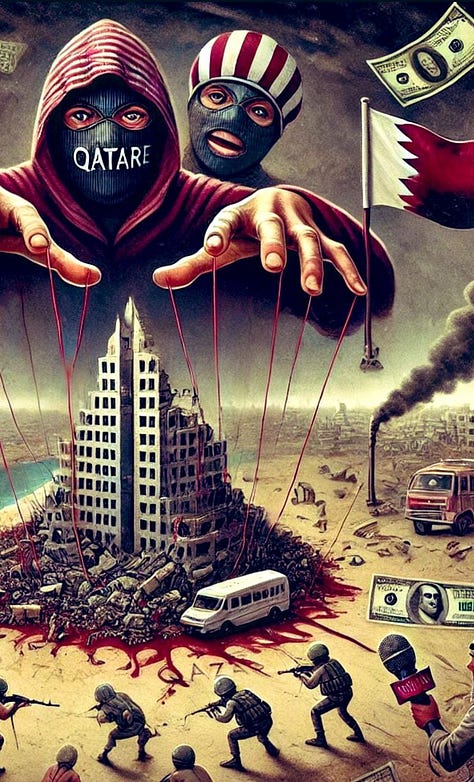
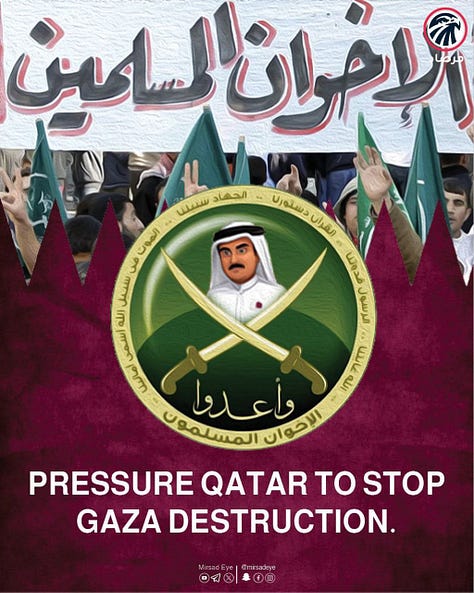
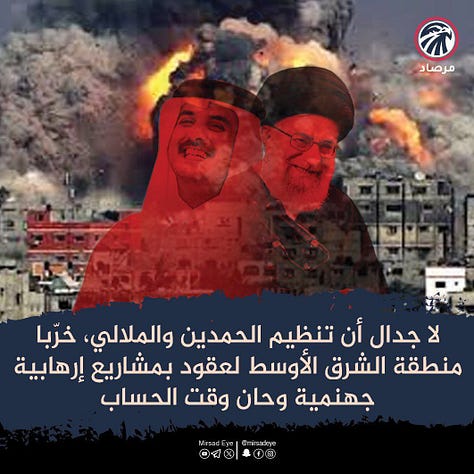



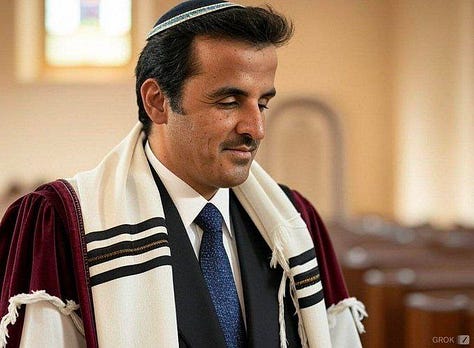
Some images were also posts from an account called mirsadeye, an account that also cross promotes an account called ‘terror alarm’, which looks like a sketchy pro-Israel propaganda outfit claiming to AI to track terror activity. Terror Alarm describe their mission as “We have no 'agenda' except to prevent acts of terror, stop antisemitism, and support Israel, Taiwan, Kosovo, Kurdistan, and Ukraine. Most of the posts on our Terror Alarm Twitter, Telegram, Facebook, Instagram, Threads, and BlueSky feeds are AI-generated and as such, they are technically agenda-free posts.” It is not clear if this bot network is linked to them, or just sharing their content.
Final note
With 560 accounts posting identical hashtags at precise intervals, the operation achieved trending status on X despite obvious coordination, highlighting X’s inability or unwillingness to counter relatively crude manipulation.
Link to data:









